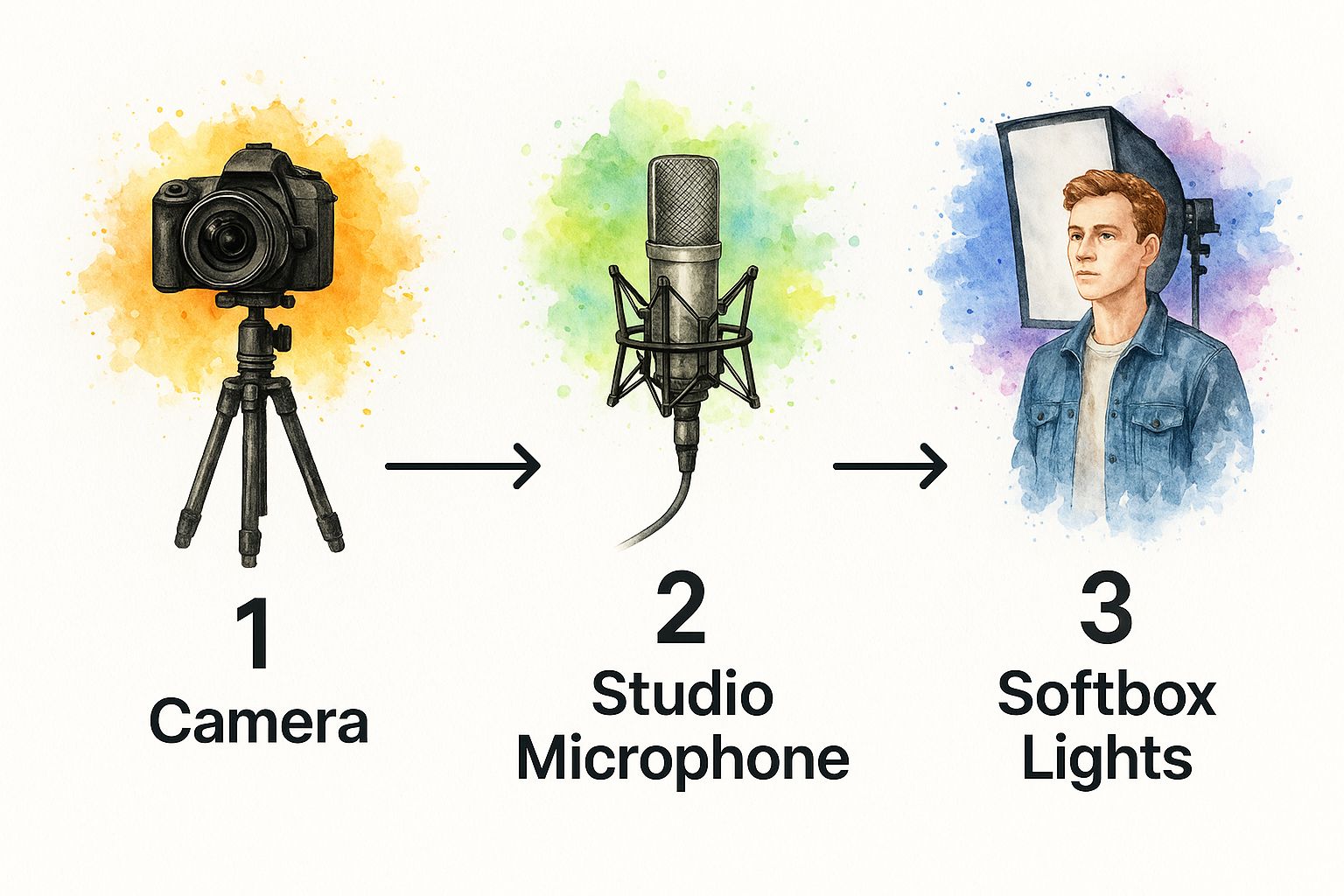Ditch the chaos and build a modern content creation workflow. This guide outlines a proven framework for scaling quality content from ideation to promotion.
In This Article
Subscribe to our newsletter
A solid content creation workflow is more than just a checklist; it's the repeatable, structured process that takes your team from a spark of an idea all the way to hitting 'publish' and getting it in front of the right people. Think of it as the strategic roadmap that keeps your content consistent, high-quality, and efficient. It turns random creative acts into a predictable engine for growth.
Without one, you're just guessing.
Why Your Old Workflow Is Holding You Back

Does your content process feel like a frantic, last-minute scramble? Are the results all over the place? If that sounds familiar, you're not alone. Too many teams are still operating with outdated—or nonexistent—workflows, relying on disjointed tasks and a "get it done" mentality that just doesn't cut it anymore.
The digital world is more crowded than ever, and what your audience wants has completely changed. A few years back, you could get by with a quick 500-word blog post. Today, that same audience expects much more. They're looking for deep-dive guides, data-packed infographics, and compelling videos that actually solve a problem for them. Simply creating content on the fly is like shouting into a hurricane; your message is going to get lost.
The Shift in Audience Expectations
This isn't just a fleeting trend. The demand for higher-quality, more valuable content is the new standard, driven by both user behavior and what search engines now prioritize. People are smarter, have more options, and won't stick around for shallow material.
The data backs this up. The average blog post is now around 1,427 words long, a huge 70% jump in the last decade alone. This shows a clear move toward giving audiences more substance. On top of that, people are hungry for different formats. One recent study found that 83% of consumers want to see more video content from brands, and infographics are an incredible 30 times more likely to be read than plain text articles.
A modern content creation workflow is your answer to this challenge. It shifts your team from being reactive—always scrambling to produce something—to being proactive, where every piece of content is a deliberate, strategic move.
Building an effective workflow involves several key stages. Each has a distinct purpose, moving your content from a rough idea to a polished, distributed asset.
Here's a look at the core components:
Core Components of a Modern Content Workflow
| Workflow Stage | Primary Goal | Key Activities |
|---|---|---|
| Ideation & Strategy | Generate and validate high-impact content ideas. | Brainstorming, keyword research, competitor analysis, topic clustering. |
| Creation & Production | Develop high-quality content in the chosen format. | Writing, designing, recording video, editing, and fact-checking. |
| Review & Optimization | Ensure quality, accuracy, and SEO-readiness. | Internal reviews, proofreading, on-page SEO, adding CTAs. |
| Publishing & Distribution | Get the content live and in front of the target audience. | Scheduling, social media promotion, email newsletters, outreach. |
| Analysis & Repurposing | Measure performance and maximize content value. | Tracking KPIs, reporting, identifying repurposing opportunities. |
Each stage builds on the last, creating a system that ensures nothing falls through the cracks.
From Cost Center to Growth Engine
An inefficient process doesn't just create subpar content; it actively bleeds time and money from your business. Without a clear plan, you're guaranteed to run into bottlenecks, missed deadlines, and a brand message that's all over the map. Every project becomes a fire drill, sucking up creative energy that should be going toward real innovation.
A structured process changes the game entirely, turning content from an unpredictable expense into a reliable asset. By defining clear stages for ideation, production, and distribution, you build a system that can scale.
It helps you:
- Improve Consistency: Make sure every single piece of content hits your quality and brand standards.
- Boost Efficiency: Stop wasting time by clearly defining roles, handoffs, and what "done" looks like.
- Achieve Better Outcomes: Tie your content directly to business goals to drive real results like traffic, leads, and sales.
To truly level up your content game, adopting a modern approach is non-negotiable. Check out this battle-tested content creation workflow for a great blueprint you can adapt to build your own powerful system.
Generating Ideas That Drive Results
Every killer piece of content starts with a solid idea. But here’s the thing: the best ideas don’t just pop out of nowhere during a random brainstorming session. They come from a smart, repeatable process. A truly efficient content creation workflow needs a reliable engine for digging up high-impact topics your audience actually wants to see.
This isn't about guesswork. It’s about being a detective. You need to hunt for clues about what your audience is struggling with and where your competitors are dropping the ball. When you take this approach, every piece of content you create is set up for success from the very beginning.
Uncover Topics with Competitor Gap Analysis
One of the smartest places to start is by looking at what your competitors are doing—and, more importantly, what they aren't. A competitor gap analysis is your secret weapon for finding valuable topics they’ve either missed or only covered superficially.
First, pull together a list of your top three to five direct competitors. Then, use an SEO tool to see which of their content is getting the most traffic. Your goal is to find keywords they rank for, but where their content is weak, old, or missing a key format like video. That's your opening.
For example, maybe a competitor has a super popular blog post on "improving ad sales with digital content." If they don't have a video on that topic, you've just found a golden opportunity. You can use a tool like Aeon to quickly create a dynamic video series that summarizes their key points, adds fresh expert insights, and delivers the info in a much more engaging way. You're not just ripping off their idea; you're filling a format gap and delivering way more value.
Tap into Real-World Customer Pain Points
Your customer service and sales teams are sitting on a goldmine of content ideas. They're on the front lines every single day, hearing directly from your customers and prospects about their biggest challenges, questions, and frustrations. What questions do they find themselves answering over and over? What problems are people trying to solve when they reach out?
Create a simple system to capture all this goodness:
- A Shared Hub: A simple shared doc or a dedicated Slack channel is perfect. Your customer-facing teams can drop in common questions and pain points as they come up.
- Quick Syncs: Set up a short monthly meeting with these teams to chat about the recurring themes they're noticing.
- Ticket Analysis: Dive into your support ticket logs. If 20% of your support queries last month were about integrating a certain tool, that's a massive flashing sign telling you to create a detailed how-to guide or a video tutorial.
Turning real customer problems into content is a powerful move. You create resources that are instantly valuable, and it shows your audience that you're actually listening. This is how you build trust and become the go-to authority in your space.
This method ensures your content isn't just built for search engines, but is laser-focused on solving the real-world problems of your ideal customers.
Find What Your Audience Is Actively Searching For
While competitor and customer insights give you a fantastic starting point, you still need to see if people are actually searching for these ideas online. This is where keyword research comes in. It helps you understand the exact words and phrases your audience uses when they're looking for answers.
Jump into an SEO tool and look for keywords with decent search volume and a difficulty level you can realistically compete for. And don't just chase the big, broad keywords. The real magic is often in long-tail keywords—those longer, more specific phrases that show someone is deep into their research and ready for a specific solution.
For instance, instead of targeting a massive term like "video marketing," you might find a sweet spot with something like "how to turn blog posts into videos for social media." That query screams intent.
To really get results, your ideation phase has to be robust. It’s about using the most effective idea generation methods to build a strategy that covers all your bases. Blending data-driven research with these human-centric insights is what separates decent content from truly great content.
Building Your Content Production Engine
Once your idea-generation machine is humming along nicely, the real work begins. It’s time to shift your focus to execution. This is the production phase of your content creation workflow—the part where raw concepts get turned into polished, high-value assets. It's all about moving from a great strategy to a tangible piece of content without losing momentum or, more importantly, quality.
This is where so many content teams, big and small, hit a wall. Without a clear process, creation descends into chaos. You end up with inconsistent outputs, missed deadlines, and a fast track to creator burnout. A well-defined production engine, on the other hand, keeps the entire system moving smoothly.
This visual breakdown shows the core flow, from the initial brief to the final asset, highlighting the key checkpoints that ensure both quality and efficiency.

As you can see, a successful production process isn't just a straight line. It's a cycle of creation, feedback, and refinement that guarantees the final output is as strong as it can be.
Crafting Detailed Content Briefs
If there’s one thing that will make your production process smoother, it’s the content brief. Seriously. Think of it as the architectural blueprint for your content. A well-crafted brief eliminates guesswork, gets everyone on the same page, and sets crystal-clear expectations right from the start. It’s the ultimate handoff document between your strategy and creative teams.
A solid brief is more than just a topic idea. It needs to be a comprehensive guide for the writer, designer, or video producer who will bring it to life.
Here's what I recommend including in every single brief:
- Target Audience: Who are we talking to? Get specific. Describe their pain points and what they desperately need to learn.
- Primary Goal: What do we want this content to actually do? Is it to drive demo sign-ups, rank for a specific keyword, or build our authority on a topic?
- Key Talking Points: List the core messages and subtopics that are non-negotiable.
- Brand Voice and Tone: Don't just say "professional." Provide examples. Are we aiming for an expert and authoritative tone, or something more conversational and witty?
- Target Keywords: Include the primary keyword and a handful of secondary keywords to give your SEO efforts a clear direction.
Investing a little extra time in a detailed brief will save you a massive amount of time on revisions. It practically guarantees the first draft is already 80% of the way to the finish line.
Using AI for First Drafts and Outlines
The creation phase is where your team’s unique creative skills should be front and center. But let's be honest, repetitive tasks like structuring an article or banging out a basic script can drain that valuable energy. This is the perfect spot to bring in an AI assistant like Aeon.
Aeon’s AI tools can take that detailed content brief you just made and instantly generate a structured outline or even a complete first draft. This doesn't replace your creative team; it supercharges them. Instead of staring at a blank page, your writer gets a solid foundation to build upon, freeing them up to focus on adding unique insights, compelling stories, and expert analysis.
This approach completely flips the script on content creation. AI handles the foundational grunt work, which allows your human talent to focus on the high-impact creative tasks that truly make your brand stand out.
Imagine you have a brief for a video on "Ad Sales Trends." You can feed that right into Aeon to produce a script outline, complete with scene suggestions and talking points. Your video team can then take that outline and run with it, adding expert interviews and custom graphics. You've just cut your production time in half. We dive deeper into this in our guide on automating content creation with smart AI tools.https://project-aeon.com/blogs/automating-content-creation-with-smart-ai-tools
Managing Feedback and Version Control
Collaboration is critical, but it can get messy—fast. Endless email threads with conflicting feedback and confusion over which file is the "latest" version are notorious workflow killers. To produce content at scale, you absolutely need a centralized system for feedback and approvals.
This is where project management tools become your best friend. By keeping all communication and file versions in one place, you establish a single source of truth that everyone can rely on.
Here are a few best practices to adopt immediately:
- Centralize All Feedback: Use the comment features built into your project management tool or collaborative documents (like Google Docs). No more feedback via email or Slack DMs.
- Assign a Decider: To avoid stalemates, designate one person who has the final say when feedback is conflicting.
- Use Clear Naming Conventions: A simple versioning system (e.g.,
Article_V1,Article_V2_review,Article_FINAL) works wonders to prevent confusion.
The time commitment for creating content varies wildly. Research shows 36% of creators spend just 1-5 hours a week, while a dedicated 5% are putting in over 40 hours. This huge range highlights the need for a workflow that's adaptable enough for both small-scale creators and full-time content teams.
Ultimately, the goal is to build a production engine that is both efficient and flexible. To truly get more from your efforts, it's worth learning how to streamline business processes for better ROI. By combining detailed briefs, smart AI assistance, and structured collaboration, you’ll be set up to consistently produce high-quality content, no matter the scale.
Refining and Optimizing Your Content
Let’s be honest, hitting 'publish' on a first draft is tempting, but that’s not how great content gets made. The real magic happens next, in the refining and optimization stage. This is where a decent piece of content evolves into a strategic asset that actually drives results.
This isn't just about a quick spell-check. It’s a multi-layered process that separates content that simply exists from content that performs. We're talking about a thorough review for clarity, a final proofread for that professional polish, and smart on-page SEO integration to get found by search engines.
Implementing a Multi-Layered Editing Framework
Relying on a single pair of eyes is a recipe for mediocrity. To truly elevate your content, you need a review process with multiple layers, each designed to catch different kinds of issues. The best approach moves from big-picture feedback down to the smallest grammatical details.
I like to think of it as a content quality control line. The first stop should be a peer review. Get a colleague to read it and ask the tough questions: Does the argument make sense? Is the main point clear? A fresh perspective here is invaluable for spotting confusing sections or areas where you could make a stronger point.
Once the structure is solid, it's time for the final polish. This is when you bring out the fine-tooth comb and hunt down every typo, grammatical mistake, and clunky sentence. This last proofread is what gives your content credibility and a professional feel.
A robust review cycle is your best defense against errors and mediocrity. It ensures accuracy, clarity, and brand consistency, turning a good draft into an authoritative piece your audience will trust.
Integrating On-Page SEO During the Editing Phase
SEO isn’t an afterthought you can just tack on at the end. It needs to be woven directly into your editing process. As you're refining the words, you have the perfect chance to optimize the content for search engines without making it sound robotic.
And this goes way beyond just stuffing keywords in. It’s about building a strong technical foundation that signals to Google and other search engines what your content is about and why it's a valuable answer for searchers.
Here’s a practical checklist I use for on-page SEO integration:
- Natural Keyword Placement: Make sure your primary keyword shows up naturally in your title, the first paragraph, and a couple of H2 subheadings. Then, sprinkle in your secondary keywords where they make sense.
- Compelling Meta Descriptions: Write a short meta description (aim for around 155 characters) that acts as a mini-advertisement for your content on the search results page. It should be compelling enough to earn the click.
- Smart Internal Linking: Add links to other relevant articles on your own site. For example, since we're discussing this topic, you might also want to check out our complete guide on how to create engaging content that actually works. This helps users find more of your great content and improves your site's overall structure.
- Image Optimization: Every image needs descriptive alt text. This is crucial for accessibility and also gives you another opportunity to use your keywords where they fit naturally, helping you rank in image search.
By baking these steps directly into your editing workflow, you guarantee that every piece of content you ship is not just well-written, but also primed to attract organic traffic. You’re not just publishing an article; you're building a long-term asset for your business.
Maximizing Reach With Smart Distribution

Creating incredible content is only half the battle. If nobody sees it, did it even happen? This is where the real work begins: getting your content in front of the right audience. A smart distribution strategy is what turns a single great asset into a multi-channel campaign that actually drives traffic and engagement.
But before you start promoting, it’s worth doing a quick pre-flight check. This is all about making sure your content is ready for primetime the moment you hit publish. It means double-checking your formatting for scannability, ensuring all your links work, and confirming that on-page SEO basics like meta descriptions and alt text are locked in.
Once the technicals are solid, you can shift your focus to building a distribution engine that works for you.
Building Your Multi-Channel Strategy
Putting all your eggs in one basket is a risky game. To get the most out of every piece of content, you need to meet your audience where they already hang out. This doesn’t mean you have to create brand-new content for every single platform. The secret is to smartly repurpose your core asset.
For instance, one in-depth pillar article can be sliced and diced into a dozen micro-assets. That single post can easily become:
- A sharp, visual carousel for Instagram or LinkedIn highlighting key stats.
- A few short, punchy video clips for TikTok and YouTube Shorts, made in minutes with Aeon.
- A detailed thread for X (formerly Twitter) breaking down the main arguments.
- An exclusive summary or bonus insight for your email newsletter.
This "create once, distribute everywhere" model is the foundation of an efficient workflow. It gets your message out there without forcing you to constantly reinvent the wheel.
The real goal of distribution is to extend the lifespan and impact of every single asset. Smart repurposing lets a pillar post generate traffic and conversation for weeks, not just days, by adapting its core message for different platforms.
Smart Social Promotion and Community Outreach
Just dropping a link with the article title won't cut it. To do social promotion right, you have to tailor your message to the unique vibe of each platform. For LinkedIn, that might mean focusing on professional takeaways. On Instagram, a striking graphic or video is essential.
Community outreach is another powerful—and often overlooked—tactic. This means finding the online communities where your audience gathers, whether it's on Reddit, in Facebook groups, or on industry forums. The key here is to add value first. Don’t just parachute in, drop a link, and leave. Join the conversation, answer questions, and only share your content when it genuinely helps.
This approach builds trust and drives highly qualified traffic from people already interested in your topic. To pull this off, you need an efficient process. This has become critical as the creator economy has exploded. Since 2020, over 165 million new creators have joined social media, and 6 in 10 are juggling it with full-time jobs.
For agencies building these systems at scale, a defined plan is a must. You can dive deeper into building a powerful promotion engine with our guide on content distribution strategies for modern agencies.
By combining a technical pre-publish check with a multi-channel repurposing strategy and targeted outreach, you turn publishing from a final step into the start of a powerful promotional cycle. This ensures every piece of content works as hard as possible to hit your goals.
Have Questions? Let's Talk Workflow.
Even with a solid plan, building a new process from the ground up always brings up real-world questions. Once you start putting a structured content creation workflow into practice, you’ll inevitably hit a few snags. This is where we get practical.
I’ve gathered some of the most common questions I hear from teams just like yours. My goal is to give you clear, no-nonsense answers to help you iron out the kinks and get your system running smoothly.
I Have No Workflow at All. Where Do I Even Start?
Feeling overwhelmed by a blank slate is normal, but trust me, it’s a massive advantage. You get to build a system from scratch without having to unlearn any bad habits. The best place to begin is almost laughably simple: just write down what you’re doing right now.
Seriously. Take one piece of content and map out its entire journey. From the "aha!" moment of the idea to the final click when you post it on social media. This simple exercise is like turning on the lights in a dark room—you'll immediately see where things are getting stuck or confused.
Once you have that messy, honest map, you can start to bring in some order:
- Create Your Buckets: Group your current jumble of tasks into the basic stages we talked about—Ideation, Creation, Review, and Distribution.
- Pick a Point Person: For each stage, assign a single owner. This isn't about hierarchy; it's about clarity. When one person is accountable, things get done.
- Aim for "Good Enough": Don't try to build the perfect, all-encompassing system on day one. Your only goal is a "minimum viable workflow" that solves your biggest headaches first.
The point isn’t perfection. It’s progress. A simple checklist in a shared Google Doc can be a ridiculously powerful starting point for any team.
From there, you can layer in new tools and more detailed steps once your team gets the hang of the basic rhythm.
What Are the Best Tools for Managing a Workflow?
Let me be blunt: the "best" tool is the one your team will actually open and use every day. There are hundreds of powerful project management platforms out there, but dropping a complex system like Jira on a team that’s used to Post-it notes is a recipe for disaster. The trick is to match the tool to the team, not the other way around.
Here’s how I think about it based on team size:
| Team Size | Tool Complexity | Examples |
|---|---|---|
| Solo Creator / Small Team | Low (Checklists & Kanban) | Trello, Asana (Free Tier), Google Docs |
| Growing Team (5-15) | Medium (Templates & Automation) | Asana, Monday.com, ClickUp |
| Large Organization | High (Integration & Reporting) | Jira, Wrike, Enterprise-level platforms |
For most creative teams just getting organized, you can't go wrong with a visual Kanban board. Tools like Trello or Asana are brilliant because they make progress tangible. Seeing a task card move from "To Do" to "In Progress" to "Done" provides a shot of dopamine and, more importantly, gives everyone instant clarity on where things stand. That visual transparency is often the single biggest win you can get right away.
How Often Should I Revisit and Update My Workflow?
Your workflow isn't a stone tablet. It's a living, breathing part of your team that needs to adapt as you grow and your goals change. If you just create a process document and file it away, it'll be useless in six months.
As a baseline, I recommend a formal review of your entire workflow at least twice a year.
But the real magic happens in the smaller, more frequent tweaks. The best way I’ve found to do this is with a quick "retrospective" meeting. Hold one after every big campaign launch or just at the end of each month.
In that meeting, ask your team three dead-simple questions:
- What went well? Celebrate what's working. What parts of the process felt smooth and helped you do great work?
- What was a pain? Get specific. Where were the bottlenecks? Where did communication break down? Where did tasks get dropped?
- What’s one thing we can change? Don't try to fix everything at once. Agree on one or two concrete changes to test out before the next check-in.
This constant feedback loop is what separates a decent workflow from a truly high-performing one. It ensures your process is always getting a little smarter and keeps small frustrations from turning into massive, team-wide problems.
Ready to supercharge your content production engine? Discover how Aeon can automate your video creation, turning your existing content into engaging videos at scale. Learn more and get started today!


.jpg)